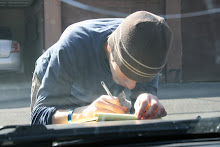December 22, 2005, started out as any other day. The Christmas spirit was in the air and everyone was getting ready for the magical 25th. It was a relatively warm day for December (I remember wearing a tee shirt). My Christmas shopping was complete with the exception of one very important thing: my mother's gift card to the ever popular Target. Realizing how important this was to her, I made it my priority for the day. So, at about 5:30 p.m., I decided to make the drive out to the local Target. Little did I know that this simple act of kindness would end up becoming the worst day of my life.
My mission was simple: drive to Target, pick up the gift card and then drive home. How hard could it be? I had made that drive numerous times without incident. So, without a care in the world, I hopped in my trusty green machine: a 1998 Jeep Cherokee Classic. This was one of teh most beautiful pieces of machinery I had ever laid eyes on. It was fast, smooth and a dream to drive. It made a wonderful roar that made you want to waste even more fuel than you already were. But, most important of all, it had soul. I don't know how Jeep did it, but that thing was addictive to drive. This made the trip out to West Knoxville actually enjoyable.
I started the green machine up and was greeted with the ever familiar song of a 4.0 liter straight six and cooling fans. And just like that, I was off. In no time at all, I had arrived at my destination. I made the short walk inside Target and purchased the card to my mother's happiness. It was time to go home, so I jumped into my Jeep and drove off into the distance. I was feeling pretty good as I listened to the sound of the band Bush. Little did I know that in two minutes, my joy would be crushed, thrown to the ground and stomped on until it didn't exist.
As most sad stories go, they end badly. Welcome to the unpleasent ending. As I drove home, I came across an intersection that I had driven through plenty of times. The light was green, I needed to turn left, so I went for it. I made it across the white line and then, in mid turn, everything stopped. You see, at the same time I was making my turn, a senior at Bearden High School was making his speedy getaway through the intersection. It wasn't until mid turn that I was his red Toyota Tundra. I will never forget what happened next.
When you get into an accident, you know it's going to happen. Everything slows down so you can remeber it. I had no control over my body and neither did the operator of the Tundra. The only thing I could do was hold on as the Tundra slammed into the front left fender of my Jeep. I won't lie, it hurt. Both of my airbags went off, with the one on the right hitting me square in the face. My week old Dr. Pepper spilled all over my leg. I was cold, wet, scared and most of all, angry. The F-word spewed from my mouth like it was the only word I knew. After everything settled down, I decidet to do the normal human thing and get out to survey the damage. Let's just say it wasn't pretty.
My green machine was injured and it was bad. His lungs were punctured and green fluid was spilling out onto the cold street. His ankle was shattered and his foot was bent in the opposite way. He would never walk again (unless you replaced the radiator and front differential). I had done the unthinkable. I had shoved my best friend into the moving path of a tank. It was over. To quote my father, "One minute you're driving along in your Jeep, and just like that, you're sitting at home with your driving privileges taken away." Thanks dad.
I, as well as the senior from Bearden, walked away from the accident with nothing but a bruise. But unlike the Tundra driver, who I overheard mentioning to his mother that he could finally get something with four wheel drive, I was had lost a true friend. I'll never forget that day as it in some way made me a better person. That day taught me to cherish everything you've got because just like that, it can be taken away.
Rest in Peace Mr. Jeep.

